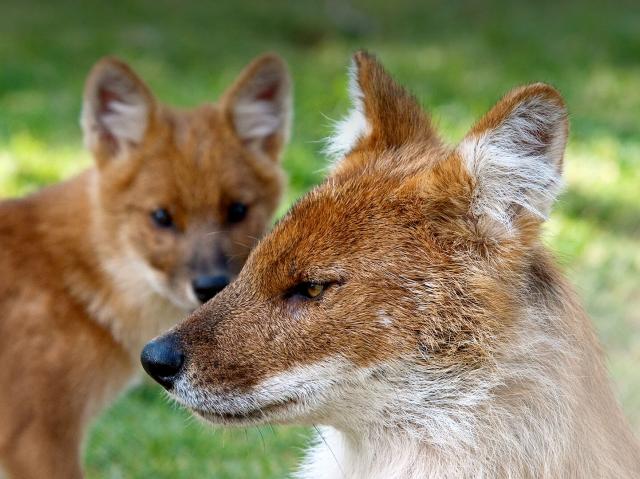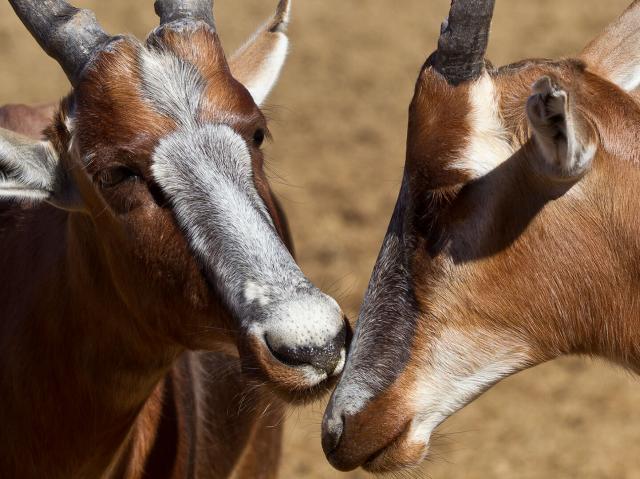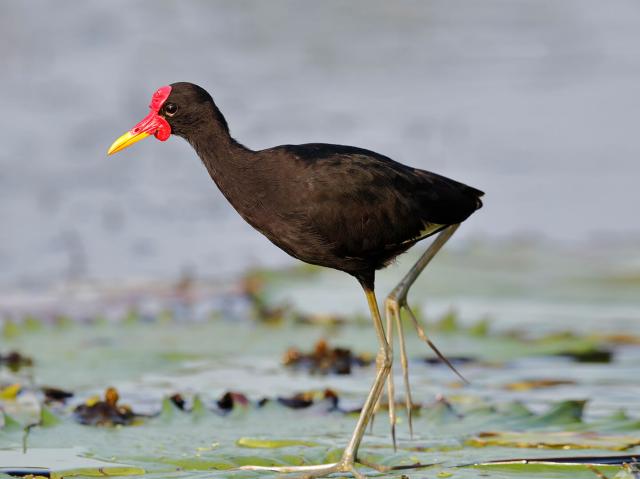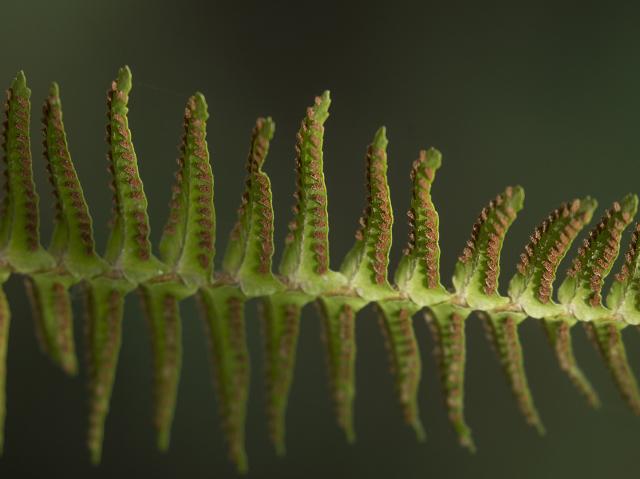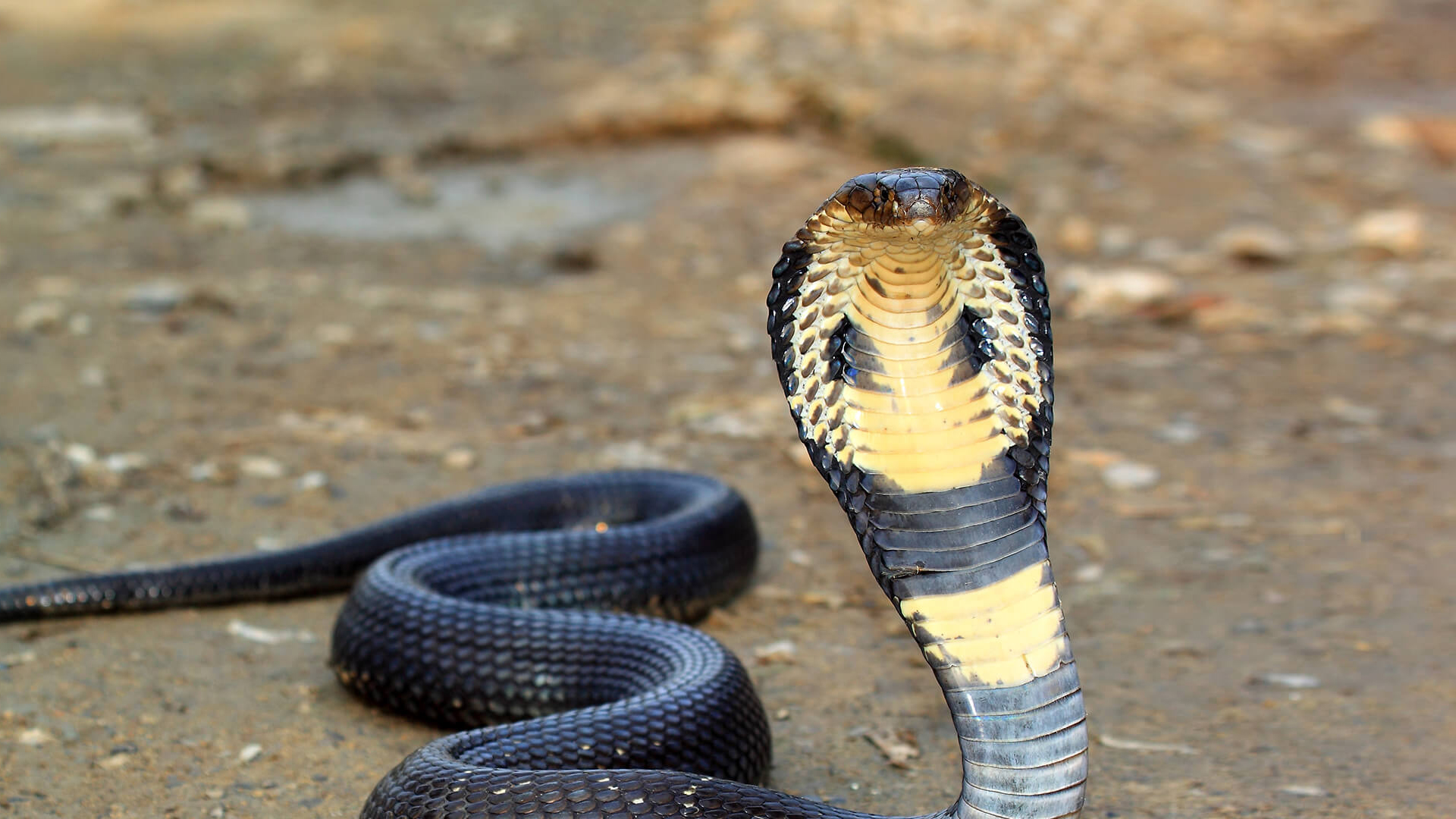
Cobra

- Class: Reptilia (Reptiles)
- Order: Squamata
- Family: Elapidae
- Genera: Ophiophagus (king cobra), Naja, Paranaja, Pseudohaje
- Species: More than 20

ABOUT
Don't hate me because I'm venomous. Cobras are venomous snakes related to taipans, coral snakes, and mambas, all members of the Elapidae family. Snakes in this family cannot fold their fangs down, as vipers can, so the fangs are generally shorter. They kill their prey by injecting venom through their fangs. The venom is a neurotoxin that stops the victim's breathing and heartbeat. A cobra only attacks a human if it feels threatened. As with any venomous snake, a bite from a cobra can be deadly if not treated properly.
Life in the hood. Cobras come in varying colors from black or dark brown to yellowish white. They have specialized muscles and ribs in the neck that can flare out when the cobra feels threatened. Cobras are able to raise their body up, spread the hood, and hiss loudly to scare off most threats.
The deep loud hiss of a large king cobra alone is enough to make one's hair stand up on end! This works much the same way as the rattle of the rattlesnake works: it is a warning sign that can be heard at a safe distance. The message is, "I am big, bad, and will bite you if you come any closer!"
What predator would even try to attack a cobra? The snake's biggest enemy is the mongoose, which is quick enough to dart in and bite the back of the cobra's neck before the snake can defend itself.
"Spitting cobra" refers to any one of several cobra varieties that have the ability to spit or spray venom from their fangs in defense. Some include the red spitting cobra, the Mozambique spitting cobra, and the black-necked spitting cobra. The venom, although not generally fatal on contact, can cause permanent blindness if it gets into the eye and/or skin, scarring if left untreated.
Despite their name, these snakes don't actually spit their venom. They spray the venom by squeezing their muscles on the venom glands, forcing the venom out of front openings in the fangs. When cornered, some can "spit" their venom up to a distance of 6.5 feet (2 meters). Four out of seven cobra varieties found in Africa and seven out of nine found in Asia can spit. While this is typically their form of defense, all spitting cobras are also able to deliver venom through a bite.
Wildlife care specialists at the San Diego Zoo wear a protective shield, which covers the head and protects the eyes, when working with these snakes. A wildlife care specialist may remove the shield after cleaning the snake's habitat and find a fine coating of venom on the face plate, even though the cobra did not hood or strike!
See spot slither. The Indian cobra, or spectacled cobra, is native to India. It has a unique pattern on the back of its hood: two circular patterns connected by a curved line that looks like the cobra is wearing glasses, or spectacles. These markings are meant to look like eyes and perhaps fool a potential enemy.
You're probably familiar with this cobra: it's the snake used by snake charmers, although the practice of snake charming in India has been banned since 1991 by a wildlife protection act. The Indian cobra is an important predator, consuming large numbers of rats. And its venom components have been used in medical research for drugs that can benefit humans.
In India, the spectacled cobra is much respected and feared, even having its own place in Hindu mythology as a powerful deity. The monocle cobra also has patterns on the back of its hood, but with one circular "eyepiece," or "monocle," instead of two!
Walk like an Egyptian. The Egyptian cobra is native to the deserts of North Africa and the Middle East and is one of the largest and most common cobras in Africa. This cobra is responsible for many deaths. It is the largest of all the Naja species, with a maximum length of 9.8 feet (3 meters). The Egyptian cobra's venom is extremely toxic. Its bite can cause a quick death, and it is considered by many to be the serpent used by Cleopatra to commit suicide.
HABITAT AND DIET
Cobra home. These mighty snakes live in Africa and Asia, preferring savannas, open woodlands, plains, and rocky hillsides.
Eating out. At dawn and dusk, hungry cobras begin to move and look for a good spot to hunt for their meal. They can go for days or even months without eating, depending on how large their last meal was. The snake's slow metabolism makes this possible. A mouse, rat, ground squirrel, or rabbit are its main prey items, but cobras may also eat amphibians, birds, lizards, other snakes, and eggs.
Cobras use their forked tongue to smell prey. The tongue moves in and out, picking up odor particles from the ground and passing them over a special smelling organ in the roof of the mouth, called the Jacobson's organ. This helps the snake sniff out its next meal.
The cobra, like other venomous snakes, is lightning fast when it strikes. But it has somewhat smaller fangs, so it may strike and chew rather than strike and release, or it may strike several times until the venom has done its job.
At the San Diego Zoo, the cobras eat thawed mice and rats.
FAMILY LIFE
Hooded hatchlings. A cobra female produces a clutch of eggs each year and usually stays nearby to guard her eggs until they hatch. A baby cobra, like all snakes, is called a hatchling. It is able to take care of itself from the start and can spread its hood and strike on the same day it hatches. A large yolk sac remains in the hatchling's stomach to give it nourishment for up to two weeks before it needs to find food on its own.
The king cobra may grow to be 18.5 feet (5.7 meters) long, making it the largest venomous snake in the world. It is found throughout India, southern China, and Southeast Asia. The king cobra usually eats other snakes, even venomous ones! If it feels threatened, the king cobra flares its hood, makes a high-pitched hiss, and rears itself up. How high? Up to one-third of its body length. In some cases, this can make the cobra taller than an average man!
Nesting instinct. Most cobras are known to protect their eggs after they are laid, but the mother king cobra takes it a step further. Before she lays her eggs, she builds a nest with leaves, using her body and head to move things. She then lay her eggs, covers them with leaves, and places herself on top to incubate them until they hatch.
The hatching of Indian cobras in the San Diego Zoo's Reptile House made headlines in 1946, for they and their predecessor, hatched here in 1944, were the first cobras to hatch in a zoo in the US. Only two of the eight eggs laid in 1944 hatched, but all of the nine eggs in the 1946 clutch yielded perfect and very much alive miniatures of their parents, which were imported from India in 1940. An African cobra, brought to the Zoo in 1928, held a record for length of life of cobras in human care at that time.
CONSERVATION
The International Union for Conservation of Nature (IUCN) evaluates the conservation status of plant and animal species, with the particular goal of identifying species at risk of extinction. The results are published in the IUCN Red List of Threatened Species.
IUCN lists several cobra species as Vulnerable or Near Threatened, and one, the São Tomé Cobra, is endangered. Chief threats are trapping and converting land for farming. Wildlife traffickers sometimes take cobras for an illegal, international pet trade.
Sounds
LIFE SPAN
20 to 30 years
YOUNG
Incubation: 45 to 80 days, depending upon species
Eggs: 12 to 60, depending upon species
Size at hatch: 16 to 18 inches (40 to 45 centimeters) long
Maturity: 4 to 6 years old
SIZE
Longest: King cobra grows up to 18.5 feet (5.7 meters); most between 3 and 7 feet (0.9 to 2.1 meters)
Weight: Up to 20 pounds (9 kilograms), depending upon species
FUN FACTS
Some cobra species "play possum" and may pretend they are dead by convulsing and then lying completely still until the threat has passed.
Like all snakes, a cobra's jaws have two independent bones that are loosely attached to its skull. This lets the snake swallow an animal that is wider than its own head.
The sight of a large cobra reared up in a bold warning stance is known to stop elephants in their tracks.




